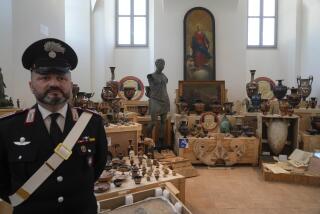Rare Getty Statue May Be Smuggled, Italy Says
- Share via
Italian authorities have initiated an inquiry into the J. Paul Getty Museum’s acquisition of a rare 5th Century B.C. statue, expressing concern that the piece--revealed to a dazzled art world only last week--might have been unearthed by scavengers and smuggled out of Sicily a decade ago.
Interviews with law enforcement authorities and art officials Tuesday suggested that the inquiry was rooted less in hard clues than in scholarly deduction and rumors of archeological grave robbing in the region where the statue is believed to have originated.
The large, limestone-and-marble statue is believed to date from 420 B.C. and represent Aphrodite, the Greek goddess of love. The statue was unknown to the art world before the Getty announced its acquisition last Thursday. Citing museum policy, Getty officials have declined to discuss where they bought the artwork or how much they paid for it.
John Walsh, director of the Getty, insisted that all the proprieties that govern international art trading had been followed. Further, he said the purchase was announced only after written confirmation was received from Italy that there were no pending claims of theft against the piece.
Through Interpol, the international law enforcement cooperative, Italian officials have asked Los Angeles police detectives to question the Getty about how it came to possess the statue.
“Interpol Rome has asked us to make an inquiry, and that is what we are going to do,” said Detective William Martin, an LAPD art fraud specialist. “We are going to talk to the J. Paul Getty Museum and find out the circumstances regarding . . . the sale or purchase of the statue.”
Martin said Interpol’s request reached him only late Tuesday. He did not expect to meet with museum officials until today at the earliest.
“It is early in the investigation; too early to know whether the statue came from Italy,” said Maj. Luigi Bacceli, commander of the Carabinieri unit responsible for safeguarding Italy’s artistic patrimony. “I’m looking for people who knew that the statue was in Sicily. It probably comes from there, but no one can say for certain.”
Suspicion that the statue might have been spirited off Sicily and at some point introduced to the art market was raised by Graziella Fiorentini, the Italian government’s director of antiquities in Agrigento, Sicily. Fiorentini, in an interview Tuesday, said that the statue could have come from Morgantina, a site in eastern Sicily that has been excavated by U.S. and Italian archeologists since its discovery in 1955 by a team from Princeton.
Rumors of Secret Digs
Fiorentini said that in the late 1970s “there were rumors of clandestine digs there, and the discovery of a large statue.”
The site is located in Sicily’s Enna Province. Artifacts spanning the centuries from ancient Greece to the late Roman Empire have been recovered at Morgantina.
“Stylistically,” Fiorentini said, “the statue could come from Morgantina.”
As at all other archeological sites in Italy, tombaroli, or grave robbers, are a constant threat at Morgantina. Fiorentini says stolen artifacts from Morgantina pieces abound on the international art market.
In the period when the statue was believed to have been created, Greeks occupied colonies on Sicily and in southern Italy, and archeological fields there have yielded treasure for authorized and unauthorized diggers alike.
“They’re probably digging out there right now,” Malcolm Bell, the Morgantina excavation director, said Tuesday night from his summer home in the nearby town of Aidone. Bell is a professor of archeology at the University of Virginia, which has continued the dig in collaboration with Princeton.
Bell said he had heard the rumors of a 1979 theft of a large statue from the ridge-site dig, which is poorly guarded. The academic diggers at Morgantina have uncovered some sculpture, but nothing to compare with the Getty’s statue.
Bell said it was he who first showed Fiorentini pictures of the statue “from the Getty,” alerting her to the acquisition.
No Information
Getty director Walsh said Tuesday that Bell had been contacted as an extra precaution against purchasing a stolen piece. The director said the museum had received “an unsubstantiated report” from a journalist he declined to identify “that mentioned the name Morgantina.”
Bell contacted museum officials by telephone, Walsh said, and informed them “that he had no information about it (the statue) and that his colleague didn’t either. We took the precaution of going back to those who know about the site, and there was no information.”
In an interview, Bell told The Times: “I think the Getty tried to find out if the statue was stolen. That’s different from trying to find out where it came from.”
Bell described the statue as “magnificent. Stylistically it is Greek-Italian, characteristic of southern Italy in the 5th Century B.C. It belongs in Italy.”
The Getty Aphrodite is a unique example of classical Greek art, but its obscure provenance is quite ordinary, according to Lori Starr, press officer for the museum.
“It is not unusual at all” to come across a prospective acquisition in the field of antiquities that has “no history or very little information,” she said. “The majority of antiquities that come on the market are like that. That is why collecting antiquities is so difficult and that’s why we acquire them so cautiously.”
” . . . Before we make an acquisition we send photographs and descriptions to agents acting on our behalf in the countries of most probable origin,” asking governments if there are any claims against the object or information about it, Starr added.
No Claims Cited
“In the case of this object, we made formal inquiries a year ago with the ministry in Rome and were notified that there were no claims,” she said.
After the Getty unveiling, the art world hailed the piece as a thrilling discovery. In a field of study that rarely produces new examples of major artworks, the statue was said to be the only full akrolithic figure in the world.
Akroliths--composites of different kinds of stone--are found in regions like Sicily that had no local source of fine marble. Greek colonists often would fashion the bulk of their figures from limestone and import marble only for heads, arms, hands and feet.
Over time, these akrolithic figures have been disassembled, broken and lost. According to Marion True, Getty curator of antiquities, only about 30 akrolithic heads can be found in museum collections around the world; none is attached to a relatively complete figure.
William D. Montalbano reported from Rome and Peter H. King from Los Angeles. Times staff writers Suzanne Muchnic in Los Angeles and Rone Tempest in Paris contributed to this story.
More to Read
The biggest entertainment stories
Get our big stories about Hollywood, film, television, music, arts, culture and more right in your inbox as soon as they publish.
You may occasionally receive promotional content from the Los Angeles Times.











